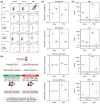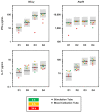Development of a Simple and Robust Whole Blood Assay with Dual Co-Stimulation to Quantify the Release of T-Cellular Signature Cytokines in Response to Aspergillus fumigatus Antigens
- PMID: 34201183
- PMCID: PMC8230040
- DOI: 10.3390/jof7060462
Development of a Simple and Robust Whole Blood Assay with Dual Co-Stimulation to Quantify the Release of T-Cellular Signature Cytokines in Response to Aspergillus fumigatus Antigens
Abstract
Deeper understanding of mold-induced cytokine signatures could promote advances in the diagnosis and treatment of invasive mycoses and mold-associated hypersensitivity syndromes. Currently, most T-cellular immunoassays in medical mycology require the isolation of mononuclear cells and have limited robustness and practicability, hampering their broader applicability in clinical practice. Therefore, we developed a simple, cost-efficient whole blood (WB) assay with dual α-CD28 and α-CD49d co-stimulation to quantify cytokine secretion in response to Aspergillus fumigatus antigens. Dual co-stimulation strongly enhanced A. fumigatus-induced release of T-cellular signature cytokines detectable by enzyme-linked immunosorbent assay (ELISA) or a multiplex cytokine assay. Furthermore, T-cell-dependent activation and cytokine response of innate immune cells was captured by the assay. The protocol consistently showed little technical variation and high robustness to pre-analytic delays of up to 8 h. Stimulation with an A. fumigatus lysate elicited at least 7-fold greater median concentrations of key T-helper cell signature cytokines, including IL-17 and the type 2 T-helper cell cytokines IL-4 and IL-5 in WB samples from patients with Aspergillus-associated lung pathologies versus patients with non-mold-related lung diseases, suggesting high discriminatory power of the assay. These results position WB-ELISA with dual co-stimulation as a simple, accurate, and robust immunoassay for translational applications, encouraging further evaluation as a platform to monitor host immunity to opportunistic pathogens.
Keywords: Aspergillus; adaptive immunity; biomarker; cytokines; immunoassay; inflammation.
Conflict of interest statement
The authors have no conflicts of interest related to this study.
Figures





Similar articles
-
Evaluation of Aspergillus and Mucorales specific T-cells and peripheral blood mononuclear cell cytokine signatures as biomarkers of environmental mold exposure.Int J Med Microbiol. 2018 Dec;308(8):1018-1026. doi: 10.1016/j.ijmm.2018.09.002. Epub 2018 Sep 3. Int J Med Microbiol. 2018. PMID: 30201279
-
Clinical-scale isolation of the total Aspergillus fumigatus-reactive T-helper cell repertoire for adoptive transfer.Cytotherapy. 2015 Oct;17(10):1396-405. doi: 10.1016/j.jcyt.2015.05.011. Epub 2015 Jul 15. Cytotherapy. 2015. PMID: 26188965
-
Chronic Occupational Mold Exposure Drives Expansion of Aspergillus-Reactive Type 1 and Type 2 T-Helper Cell Responses.J Fungi (Basel). 2021 Aug 27;7(9):698. doi: 10.3390/jof7090698. J Fungi (Basel). 2021. PMID: 34575736 Free PMC article.
-
Whole Blood Assay with Dual Co-Stimulation for Antigen-Specific Analysis of Host Immunity to Fungal and Viral Pathogens.J Vis Exp. 2024 Sep 20;(211). doi: 10.3791/66593. J Vis Exp. 2024. PMID: 39373475
-
Cytokines induce effector T-helper cells during invasive aspergillosis; what we have learned about T-helper cells?Front Microbiol. 2015 May 11;6:429. doi: 10.3389/fmicb.2015.00429. eCollection 2015. Front Microbiol. 2015. PMID: 26029179 Free PMC article. Review.
Cited by
-
COVID-19 patients share common, corticosteroid-independent features of impaired host immunity to pathogenic molds.Front Immunol. 2022 Aug 16;13:954985. doi: 10.3389/fimmu.2022.954985. eCollection 2022. Front Immunol. 2022. PMID: 36052094 Free PMC article.
-
Identification and validation of diagnostic cut-offs of the ELISpot assay for the diagnosis of invasive aspergillosis in high-risk patients.PLoS One. 2024 Jul 9;19(7):e0306728. doi: 10.1371/journal.pone.0306728. eCollection 2024. PLoS One. 2024. PMID: 38980880 Free PMC article.
-
Antigen-specific T helper cells and cytokine profiles predict intensity and longevity of cellular and humoral responses to SARS-CoV-2 booster vaccination.Front Immunol. 2024 Aug 29;15:1423766. doi: 10.3389/fimmu.2024.1423766. eCollection 2024. Front Immunol. 2024. PMID: 39267758 Free PMC article.
-
Antigen specificity and cross-reactivity drive functionally diverse anti-Aspergillus fumigatus T cell responses in cystic fibrosis.J Clin Invest. 2023 Mar 1;133(5):e161593. doi: 10.1172/JCI161593. J Clin Invest. 2023. PMID: 36701198 Free PMC article.
-
CD4+ T cells are the major predictor of HCMV control in allogeneic stem cell transplant recipients on letermovir prophylaxis.Front Immunol. 2023 May 10;14:1148841. doi: 10.3389/fimmu.2023.1148841. eCollection 2023. Front Immunol. 2023. PMID: 37234158 Free PMC article.
References
-
- Wurster S., Weis P., Page L., Helm J., Lazariotou M., Einsele H., Ullmann A.J. Intra- and inter-individual variability of Aspergillus fumigatus reactive T-cell frequencies in healthy volunteers in dependency of mould exposure in residential and working environment. Mycoses. 2017;60:668–675. doi: 10.1111/myc.12643. - DOI - PubMed
-
- Jolink H., Hagedoorn R.S., Lagendijk E.L., Drijfhout J.W., van Dissel J.T., Falkenburg J.H., Heemskerk M.H. Induction of A. fumigatus-specific CD4-positive T cells in patients recovering from invasive aspergillosis. Haematologica. 2014;99:1255–1263. doi: 10.3324/haematol.2013.098830. - DOI - PMC - PubMed
-
- Lordan J.L., Bucchieri F., Richter A., Konstantinidis A., Holloway J.W., Thornber M., Puddicombe S.M., Buchanan D., Wilson S.J., Djukanovic R., et al. Cooperative effects of Th2 cytokines and allergen on normal and asthmatic bronchial epithelial cells. J. Immunol. 2002;169:407–414. doi: 10.4049/jimmunol.169.1.407. - DOI - PubMed
LinkOut - more resources
Full Text Sources

